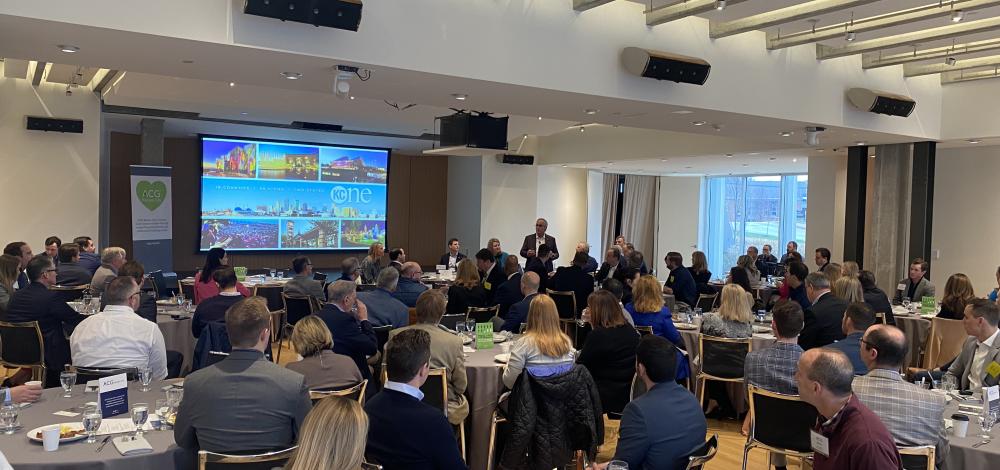
March 24, 2023

The Kansas City region is basking in the global spotlight.
On display are the new Kansas City International Airport, Panasonic’s decision to locate here, the 2023 NFL draft, the first stadium in the world built specifically for a women’s pro sports team, slated to open in early 2024, and the selection of Kansas City to host the World Cup in 2026, among other high-profile projects.
At ACG’s March 24 meeting, with the theme of purpose-driven growth, Tim Cowden, president and CEO of the Kansas City Area Development Council, and Ashley McDonald, managing director of KC Global Design, detailed the region’s recent progress and promise for the near future.
While introducing the speakers, John Shoemaker with CBIZ in Kansas City said Cowden, McDonald and their teams had attracted $7.7 billion of investment in the Kansas City area and 16,000 jobs. Kansas City ranks No, 8 among the hottest job markets in the United States, according to a Wall Street Journal story in April 2022.
Cowden said the state line separating the Kansas City area between Missouri and Kansas actually unifies the area’s purpose-driven growth, driven by regional collaboration. He thinks the reason for the region’s success is this “tremendous” amount of collaboration, cooperation and alignment of mission, though “it hasn’t always been that way.”
“We have to be incredibly intentional to collaborate because of that state line,” he said. “I truly believe it makes us better as a region because of the necessary collaboration. … That’s why KCADC was created. … We don’t care where a company locates within the region,” because the entire region benefits when companies establish a presence here.
For example, the first meeting with Panasonic executives here was held in Kansas City, Missouri, Cowden said. That emphasized for the company’s visiting executives that “you’re going to get the entirety of our region if you come here,” he said. “We don’t care where a company locates within the region. … We are on the cusp of some really cool things.”
Cowden asked the audience which cities Kansas City competes with. Their answers included St. Louis, Nashville, Indianapolis, Austin and Columbus. Kansas City competes with all those cities, he said. And it has in common with them that they all are Kansas City’s size or larger.
More people are moving to the Kansas City area, particularly younger people just out of school, Cowden said. Many of them hadn’t thought of Kansas City as a place to build their careers and lives. But they “feel the vibe, what’s happening in Kansas City.”
The top 10 states from which people are moving to the Kansas City region are: Missouri followed by Kansas, Texas, California, Colorado, Iowa, Florida, Illinois, Nebraska and Arizona.
Kansas City’s focus on architecture, engineering, construction and design—a $24 billion industry—distinguishes the region and led to the birth of KC Global Design, whose goal is to “put Kansas City on the global stage for design,” McDonald said.
She described four key elements of KC Global Design’s mission: awareness, talent, innovation and community.
- Awareness: More than a billion people saw news coverage of the new, innovative design of KCI.
- Talent: The region’s company recruiters can promote themselves, their cultures, Kansas City’s lifestyle and its lower cost of living.
- Innovation: The region boasts numerous examples of innovative design and architecture, engineering and construction in addition to KCI.
- Community: KC Global Design fosters collaboration in “putting intentionality” around nonprofits and valuing diversity to promote the region’s sense of community.
The Kansas region is home to more than 1,000 large and smaller architecture and engineering firms; has the eighth-largest concentration of this category of companies, a $24 billion industry in the region; employs 70,000 people in the region; and has four design firms headquartered here, No. 1 among the country’s top 25 design firms.
After their presentation, Cowden and McDonald took questions from the audience. One involved the importance of building the region’s labor force. Cowden emphasized and elaborated on its importance.
“We want to bring talent here but all talent needs to be educated,” he said.
That must start in grade school, he said. By 2030, every high school graduate in the Kansas City region will be certified in some specialty.
“It is a fantastic time to be in our region,” Cowden said. “This is the golden era of Kansas City.”

Register by January 14 to maximize value, elevate your experience, and get a head start connecting with 3,200+ dealmakers and executives.
